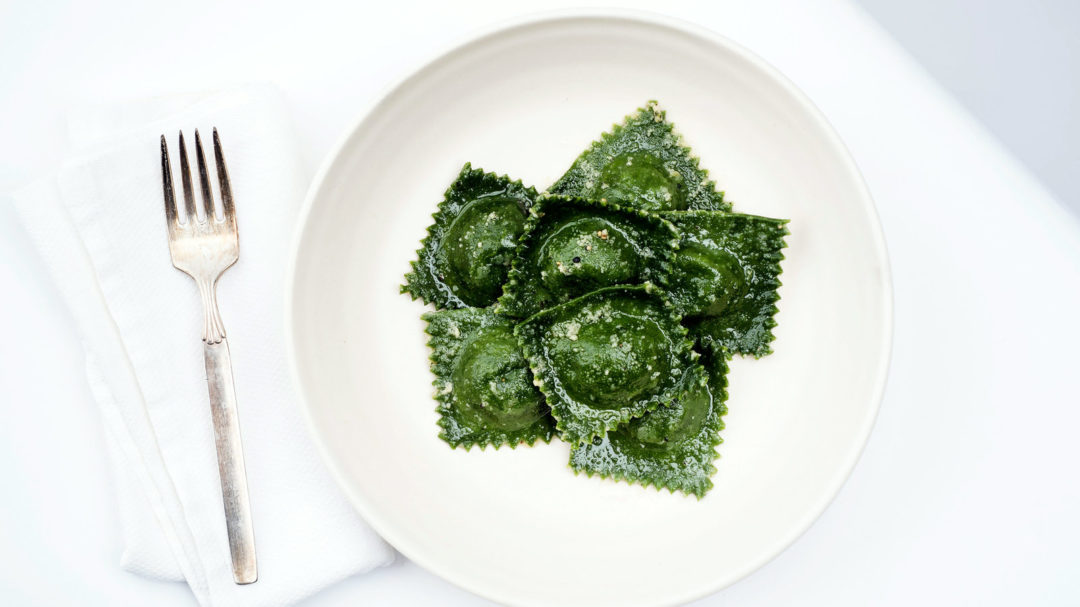
Ingredients
For the filling:
- 2bunches Swiss chard
- 3tablespoons extra-virgin olive oil
- 1medium yellow onion, diced finely
- Salt
- ½cup whole milk ricotta
- ½cup finely grated Parmesan (1 ounce)
- ⅛teaspoon freshly grated nutmeg
For the pasta:
- Sheets from 1 recipe green pasta dough (see recipe)
- Salt
For the sauce:
- 8tablespoons cold butter, cut into 1-tablespoon sized pieces
- ¼cup finely grated Parmesan
- Nutritional Information
Nutritional analysis per serving (4 servings)
301 calories; 21 grams fat; 8 grams saturated fat; 0 grams trans fat; 10 grams monounsaturated fat; 1 gram polyunsaturated fat; 17 grams carbohydrates; 4 grams dietary fiber; 4 grams sugars; 13 grams protein; 33 milligrams cholesterol; 742 milligrams sodium
Note: The information shown is DiningAndCooking.com’s estimate based on available ingredients and preparation. It should not be considered a substitute for a professional nutritionist’s advice.Powered by DiningAndCooking.com
Preparation
- Make the filling: Strip leaves away from chard, and dice the stems into 1/2-inch pieces. Set a large frying pan over medium-high heat. Add 3 tablespoons olive oil. When oil shimmers, add the onion, diced chard stems, and a pinch of salt. Reduce heat to medium and cook, stirring occasionally, for 12 to 14 minutes, until onions are tender and lightly golden.
- In the meantime, slice the chard leaves into 1-inch pieces. When the onions are tender, add the chard leaves to the onions, and cook, using tongs to turn the chard until it wilts. Season with salt. Continue cooking, stirring occasionally, for 9 to 10 minutes, until the chard is tender and sweet. Remove pan from heat and allow to cool to room temperature.
- Scrape chard into the bowl of a food processor, and add ricotta, Parmesan and nutmeg. Pulse to combine, stopping to scrape the sides of the bowl with a rubber spatula, until the chard is evenly, finely chopped. Taste and adjust salt as needed. Cover and refrigerate until ready to use.
- Make the pasta: Set a large pot filled with 5 quarts of water over high heat, cover, and bring to a boil. Add 6 tablespoons fine sea salt or 1/2 cup Diamond Crystal kosher salt.
- Place a sheet of pasta on your workspace and dust off any excess flour. Fold the sheet in half lengthwise to create a crease and unfold. Spoon tablespoonfuls of filling horizontally along the center of the pasta sheet, about an inch and a half apart.
- Using a spray bottle or damp pastry brush, very lightly moisten the entire strip. Lift the top edge of the pasta sheet and fold it down to meet the bottom edge, letting it drape loosely over the filling.
- Starting on one end, squeeze out air bubbles by pressing the dough around the filling with dry fingers (but don’t press on the filling itself). Work toward other end. Press on the edges to seal completely.
- Using a fluted pasta cutter or a knife, trim the unfolded edges of the pasta, then cut between the mounds of filling to form the ravioli.
- Toss lightly with semolina flour, then lay out in a single layer on the second prepared baking sheet. Cover with a piece of parchment paper.
- Drop 32 ravioli into water and stir, keeping an eye on them. They should cook in about 3 to 4 minutes.
- Make the sauce while the pasta cooks: Set a large frying pan with curved edges over medium-high heat and add 3 tablespoons pasta water. (The starch in the pasta water helps this emulsion stay together.)
- Bring to a simmer, then reduce heat to medium-low and add butter a piece or two at a time while continuously swirling the pan.
- Keep swirling the pan until the butter melts and the sauce begins to thicken. Remove from heat and add Parmesan, black pepper, and salt. Swirl to combine, then taste and adjust salt as needed.

Dining and Cooking